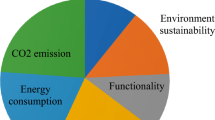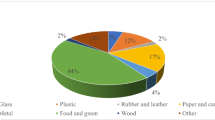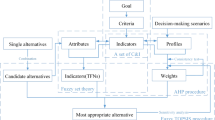Abstract
In the present context of environmental scenario, proper management of waste water from different sources is an emerging topic as the crisis of ground water is rudely seen from the last decade. This study addresses a multi-criteria decision making frame work on the selection of appropriate waste water treatment plans alternative in uncertain atmosphere. The approach merges Technique for Order Preference by Similarity to Ideal Solution method. To cultivate the indeterminacy and inconsistency on decision making with uncertainty more precisely, all the experimental data are designed in term of neutrosophic sets. Using a distance function proposed here and by practice of prospect theory, the degree of effectiveness of each treatment plan is evaluated. A user friendly algorithm is drawn to sketch that approach, and then it is demonstrated in practical field. The outcome is analysed and compared with the existing frame to validate the superiority of this work.
Similar content being viewed by others
Availability of data and material
Data sharing is not applicable to this article as no data sets were generated or analysed during the current study.
References
Abdel-Basset, M., Mohamed, M., Mostafa, N.N., El-Henawy, I.M., Abouhawwash, M.: New multi-criteria decision-making technique based on neutrosophic axiomatic design. Sci. Rep. 12(1), 10657 (2022). https://doi.org/10.1038/s41598-022-14557-4
Atanassov, K.T.: Intuitionistic fuzzy sets. Fuzzy Sets Syst. 20(1), 87–96 (1986). https://doi.org/10.1016/S0165-0114(86)80034-3
Bera, T., Mahapatra, N.K.: Neutrosophic soft matrix and its application to decision making. Neutrosophic Sets Syst. 18, 03–15 (2017)
Bera, T., Mahapatra N.K.: Ranking of thermal power plants focussing on air pollution : a Neutrosophic assessment. J. Clean. Prod. 316 (2021). https://doi.org/10.1016/j.jclepro.2021.128250
Biswas, P., Pramanik, S., Giri, B.C.: TOPSIS method for multi-attribute group decision-making under single-valued Neutrosophic environment. Neural Comput. Appl. 27, 727–737 (2016). https://doi.org/10.1007/s00521-015-1891-2
Choudhury, P., Uday, U.S.P., Mahata, N., Tiwari, O., Ray, R., Bandyopadhyay, T., Bhunia, B.: Performance improvement of microbial fuel cells for waste water treatment along with value addition : A review on past achievements and recent perspectives. Renew. Sustain. Energy Rev. 79, 372–389 (2017). https://doi.org/10.1016/j.rser.2017.05.098
Dursun, M.: A fuzzy approach for the assessment of wastewater treatment alternatives. Eng. Lett. 24(2), 231–236 (2016)
Elhassouny, A., Smarandache, F.: Neutrosophic-simplified-TOPSIS Multi-Criteria Decision-Making using combined Simplified-TOPSIS method and Neutrosophics. IEEE International Conference on Fuzzy Systems (FUZZ-IEEE), pp. 2468–2474 (2016). https://doi.org/10.1109/FUZZ-IEEE.2016.7738003
Ghosh, P., Roy, T.K., Majumder, C.: Optimization of industrial wastewater treatment using intuitionistic fuzzy goal geometric programming problem. Fuzzy Inf. Eng. 8(3), 329–343 (2016). https://doi.org/10.1016/j.fiae.2016.09.002
Hezam, I.M., Nayeem, M.K., Foul, A., Alrasheedi, A.F.: COVID-19 vaccine: a neutrosophic MCDM approach for determining the priority groups. Res. Phys. 20, 103654 (2021)
Liu, J., Li, Y., Huang, G., Chen, L.: A recourse based type-2 fuzzy programming method for water pollution control under uncertainty. Symmetry 9(11), 265 (2017). https://doi.org/10.3390/sym9110265
Karasan, A., Kahraman, C.: Selection of the most appropriate renewable energy alternatives. Informatica 31(2), 225–248 (2020). https://doi.org/10.15388/20-INFOR388
Khodadadi, M.R., Zolfani, S.H., Yazdani, M., Zavadskas, E.K.: A hybrid MADM analysis in evaluating process of chemical wastewater purification regarding to advance oxidation processes. J. Environ. Eng. Landscape Manage. 25(3), 277–288 (2017)
Li, D.F., Nan, J.X.: Extension of the TOPSIS for multi-attribute group decision making under Atanassov IFS Environments. Int. J. Fuzzy Syst. Appl. 1(4), 47–61 (2011). https://doi.org/10.4018/ijfsa.2011100104
Majumdar, P.P., Sasikumar, K.: A fuzzy risk approach for seasonal water quality management of a river system. Water Resources Res. 38(1), (2002). https://doi.org/10.1029/2000WR000126
Mahjouri, M., Ishak, Mohd B., Ali, T., Latifah, A.M., Halimoon, N., Ghoddusi, J.: Optimal selection of Iron and Steel wastewater treatment technology using integrated multi-criteria decision-making techniques and fuzzy logic. Process Safe. Environ. Protect. 107, 54–68 (2017). https://doi.org/10.1016/j.psep.2017.01.016
Mehlawat, M.K., Grover, N.: Intuitionistic fuzzy multi-criteria group decision making with an application to critical path selection. Ann. Oper. Res. 269(1–2), 505–520 (2018). https://doi.org/10.1007/s10479-017-2477-4
Pavic, Z., Novoselac, V.: Notes on TOPSIS method. Int. J. Res. Eng. Sci. 1(2), 05–12 (2013)
Ren, J., Liang, H.: Multi-criteria group decision-making based sustainability measurement of wastewater treatment processes. Environ. Impact Assess. Rev. 65, 91–99 (2017). https://doi.org/10.1016/j.eiar.2017.04.008
Smarandache, F.: Neutrosophic set, a generalisation of the intuitionistic fuzzy sets. Inter. J. Pure Appl. Math. 24, 287–297 (2005)
Tian, C., Peng, J.J., Zhang, Z.Q., Mark Goh, M., Wang, J.Q.: A multi-criteria decision-making method based on single-valued neutrosophic partitioned heronian mean operator. Mathematics 8(7), 1189 (2020). https://doi.org/10.3390/math8071189
Tversky, A., Kahneman, D.: Advances in prospect theory: cumulative representation of uncertainty. J. Risk Uncertainty 5(4), 297–323 (1992). https://doi.org/10.1007/BF00122574
Wang, H., Zhang, Y., Sunderraman, R., Smarandache, F.: Single valued neutrosophic sets. Fuzzy Sets Rough Sets Multivalued Oper. Appl. 3(1), 33–39 (2011)
Xing, Z., Xiong, W., Liu, H.: A Euclidean approach for ranking Attanasov intuitionistic fuzzy values. IEEE Trans. Fuzzy Syst. 99 (2018). https://doi.org/10.1109/TFUZZ.2017.2666219
Zavadskas, E.K., Mardani, A., Turskis, Z., Jusoh, A., MD Nor, K.: Development of topsis method to solve complicated decision-making problems: an overview on developments from 2000 to 2015. Int. J. Inf. Technol. Decis. Making 15(3), 645–682 (2016). https://doi.org/10.1142/S0219622016300019
Zhou, Z., Dou, Y., Zhang, X., Zhao, D., Tan, Y.: A group decision-making model for wastewater treatment plans selection based on intuitionistic fuzzy set. J. Environ. Eng. Landscape Manage. 26(4), 251–260 (2018). https://doi.org/10.3846/jeelm.2018.6122
Zolfani, S.H., Maknoon, R., Zavadskas, E.K.: An introduction to prospective multiple attribute decision making (PMADM). Technol. Econ. Develop. Econ. 22(2), 309–326 (2016). https://doi.org/10.3846/20294913.2016.1150363
Acknowledgements
Both authors are greatly acknowledging the suggestion of the editor to upgrade the paper for the journal format.
Funding
No funding was received for conducting this study.
Author information
Authors and Affiliations
Contributions
This work was carried out in collaboration between both authors Bera and Mahapatra. Author Bera designed the study, performed the analysis, wrote the first draft of the manuscript and managed literature searches in consultation with the author Mahapatra. Author Mahapatra managed the analyses of the study, wrote the protocol and literature searches. Both authors read and approved the final manuscript.
Corresponding author
Ethics declarations
Conflict of interest
Both authors declare that they have no any conflict of interest or no any relevant financial or non-financial competing interest or personal relationship that could have appeared to influence the work reported in this text.
Ethics approval and consent to participate
Not applicable.
Consent for publication
After acceptance of manuscript, authors provides OPSEARCH the sole right and responsibility to publish the article in printed, online or in other media formats.
Additional information
Publisher's Note
Springer Nature remains neutral with regard to jurisdictional claims in published maps and institutional affiliations.
Rights and permissions
Springer Nature or its licensor (e.g. a society or other partner) holds exclusive rights to this article under a publishing agreement with the author(s) or other rightsholder(s); author self-archiving of the accepted manuscript version of this article is solely governed by the terms of such publishing agreement and applicable law.
About this article
Cite this article
Bera, T., Mahapatra, N.K. Selection of waste water treatment plans alternative: a neutrosophy based MCDM approach. OPSEARCH (2023). https://doi.org/10.1007/s12597-023-00708-2
Accepted:
Published:
DOI: https://doi.org/10.1007/s12597-023-00708-2




